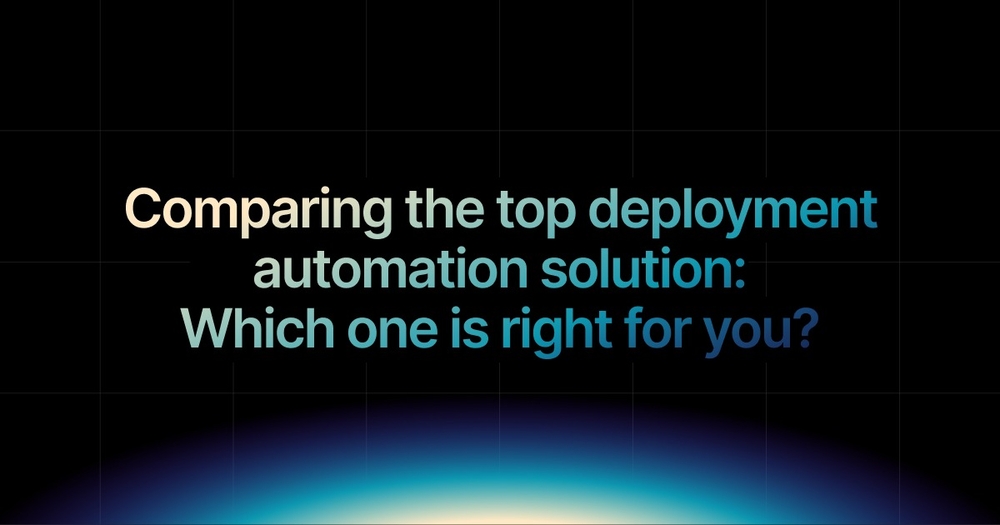Published
- 5 min read
Comparing the top deployment automation solutions: Which one is right for you?

As startups scale rapidly in 2025, automating infrastructure deployment has emerged as one of the most efficient ways to reduce time-to-market, optimise developer workflows, and control cloud expenses.
This article offers a comprehensive comparison of top deployment automation platforms Heroku, Render, Railway, Vercel, Fly.io, Sevalla, and Kuberns through an objective, informative lens.
Whether you’re leading a fast-growing SaaS company or modernising legacy deployments, you’ll find insights to guide your decision-making.
Why deployment automation matters in 2025?
 According to a 2024 CNCF survey, over 84% of organisations use containers in production, and 65% of them automate deployment tasks to some degree. The core reason? Time savings and cost predictability.
According to a 2024 CNCF survey, over 84% of organisations use containers in production, and 65% of them automate deployment tasks to some degree. The core reason? Time savings and cost predictability.
A study by Forrester shows teams that adopted continuous deployment practices cut release cycle times by 45% and reduced infrastructure-related incidents by 32%.
If you’re not already automating, you’re not just behind, you’re likely wasting developer hours and overspending on cloud.
Key evaluation criteria
 To help you assess deployment platforms effectively, we’re comparing each solution using the following dimensions:
To help you assess deployment platforms effectively, we’re comparing each solution using the following dimensions:
- Developer Experience (DevEx): how intuitive and supportive the platform is.
- Speed to Deploy: how quickly you can go from code to a running service.
- Cost Management: includes pricing transparency and built-in cost controls.
- Scalability & Flexibility: How well the platform handles growth and complexity.
- Observability & Monitoring: built-in tools for logs, metrics, and alerts.
Deployment Automation Platform Comparison- 2025
 In 2025, deployment automation platforms come in many flavors. Some favor simplicity, others target scalability. But among them, one platform that clearly stands out is Kuberns.
In 2025, deployment automation platforms come in many flavors. Some favor simplicity, others target scalability. But among them, one platform that clearly stands out is Kuberns.
Unlike most tools that focus narrowly on deployment workflows, Kuberns delivers an integrated ecosystem covering:
- Deployment automation (CI/CD and infra setup)
- Auto-scaling based on load and cost signals
- Unified logs, metrics, and AI anomaly detection
- 40% cloud cost savings on AWS
Here’s how it compares with other platforms:
Heroku is best known for its simplicity, offering a PaaS environment that’s great for MVPs and prototyping. It excels in developer experience with its well-documented CLI and marketplace of add-ons.
However, as your app scales, costs rise quickly, and flexibility becomes an issue due to limited infrastructure customisation.
Render sits between Heroku and more DIY platforms. It offers more flexibility, supporting Docker, background workers, and static sites while maintaining a relatively smooth developer experience.
Though its pricing is more competitive, advanced features still feel less mature than older platforms.
Railway has become a favourite for solo developers and teams shipping MVPs quickly. It features a very modern interface and little setup friction.
However, it’s not well-suited for projects requiring granular infrastructure control or complex production environments.
Vercel specialises in frontend applications, especially Jamstack architectures. With built-in support for serverless functions, Git-based deployments, and preview environments, it’s ideal for frontend-focused teams.
But it falls short for backend-heavy or highly customised apps, both in capability and cost efficiency.

Kuberns differentiates itself by merging enterprise-grade deployment automation with startup-friendly pricing and developer-first tooling.
It auto-detects your infrastructure, sets up CI/CD pipelines, and eliminates YAML through guided deployment flows.
What truly sets Kuberns apart is its 40% cloud cost reduction model without compromising infrastructure quality.
With built-in AI alerts, anomaly detection, and a clean UX, it serves fast-growing startups aiming to modernise their stack while keeping a close eye on cloud spend.
Looking for a deployment platform that scales with your growth and reduces cloud bills? Try Kuberns to see the difference.
How Kuberns achieves up to 40% AWS cloud cost savings?
 One of the most disruptive innovations from Kuberns is its unique cost-saving model on AWS. Rather than offering discounts through infrastructure compromises, Kuberns uses an innovative method to help startups and IT services agencies.
One of the most disruptive innovations from Kuberns is its unique cost-saving model on AWS. Rather than offering discounts through infrastructure compromises, Kuberns uses an innovative method to help startups and IT services agencies.
Here’s how it works:
- Kuberns aggregates cloud usage across multiple startups and companies, negotiating enterprise-level discounts that individual users couldn’t access alone.
- If you’re locked into a higher-priced cloud contract, Kuberns offers an optional exchange program to switch into a lower-rate, shared contract pool without affecting your infra setup.
- Kuberns shows line-by-line cloud savings in your dashboard, making it easy to attribute optimisations back to actual workloads.
“We saved over 38% on our AWS bill in the first month without touching a single EC2 instance.”, early adopter feedback
This model is especially relevant for startups scaling on cloud-native architectures who want to reinvest cost savings into growth.
Questions to ask before you choose

- What’s your monthly infrastructure budget ceiling, and how predictable is it?
- Do you anticipate needing multi-region or edge deployments as you grow?
- How hands-on do you want to be with infrastructure—do you want to manage Kubernetes or prefer it abstracted?
- Is your team actively tracking cloud costs and usage analytics today?
- Will you need integrated observability, logs, and real-time alerts, or are third-party tools sufficient?
- How critical is time-to-deploy in your product roadmap or CI/CD cycle?
- Do you plan to migrate from an existing platform soon, and what friction might come with it?
If you’re scaling quickly, optimising cost and complexity early can prevent painful platform migrations later.
Conclusion
Choosing a deployment automation platform should be a balance between cost, control, and speed.
Each of these tools serves a purpose, but only a few are built with cost-conscious, growth-stage teams in mind.
Kuberns stands out by combining flexible deployments, real-time observability, and a pricing model that scales intelligently
Instead of traditional per-resource pricing, it reduces your cloud bill via a contract exchange model, ensuring performance isn’t sacrificed.
Curious how Kuberns compares to what you’re using today? Explore the platform or join the free demo.